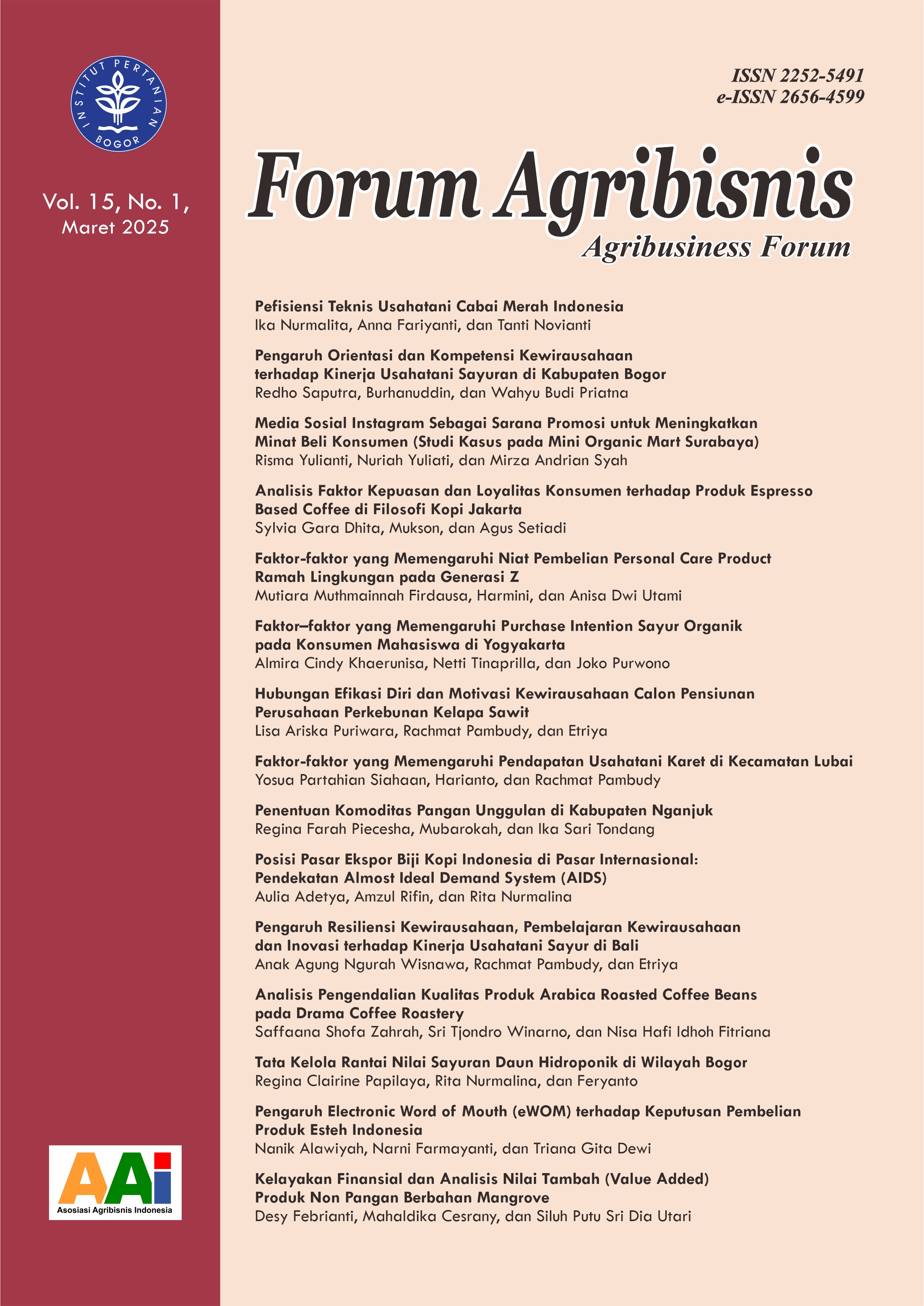Posisi Pasar Ekspor Biji Kopi Indonesia Di Pasar Internasional: Pendekatan Almost Ideal Demand System (AIDS)
Main Article Content
Abstract
Indonesia is one of the primary exporters of coffee commodities. The majority of Indonesia’s coffee production is exported abroad, while the remainder serves domestic demand. Indonesian coffee exports span five continents: Asia, Africa, Australia, the Americas, and Europe, with the main market share in Europe. This research aims to achieve two objectives: (1) analyze Indonesia’s market share in international coffee bean exports, and (2) assess Indonesia’s position in the international coffee market using the Almost Ideal Demand System (AIDS) approach. The study utilizes secondary data in the form of monthly time series spanning 12 years from 2010 to 2021, focusing on HS code 0901111 (coffee, not roasted, not decaffeinated). The research findings reveal that the average market share of Indonesian coffee bean exports in the international market is approximately 6%, positioning Indonesia third after Brazil and Colombia. This share is greater than that of Guatemala, Ethiopia, Uganda, and other exporting nations. The price elasticity of demand for coffee in Indonesia (uncompensated) is negative, specifically -0.35, indicating inelasticity (since it is less than 1). Additionally, the cross-price elasticity between Indonesia and Brazil, Colombia, Guatemala, Ethiopia, and Uganda is also negative, with respective values of 0.16, 0.32, 0.20, 0.07, and 0.02. These values suggest a complementary relationship. Furthermore, the expenditure elasticity of Indonesian coffee exports is negative, implying that Indonesian coffee falls into the category of inferior goods, with a value of 1.143, which is greater than 1, signifying elasticity.
Downloads
Article Details

This work is licensed under a Creative Commons Attribution-ShareAlike 4.0 International License.
The author submitting the manuscript must understand and agree that the copyright of the article manuscript must be submitted/transferred to the Journal Forum Agribisnis. This work is licensed under the Creative Commons Attribution-ShareAlike 4.0 (CC BY-SA) International License in which the Author and Reader can copy and redistribute the material in any media or format, and remix, modify and build material for any purpose, but they must provide appropriate credit (citing articles or content), provide a link to the license, and indicate whether there is a change. If you mix, change, or create material, you must distribute your contribution under the same license as the original.
References
Amanda, S., & Rosiana, N. (2023). Analisis Daya Saing Kopi Indonesia dalam Menghadapi Perdagangan Kopi Dunia. Forum Agribisnis, 13(1), 1–11. DOI: https://doi.org/10.29244/fagb.13.1.1-11/.
Annisa, D. I., Rifin, A., & Novianti, T. (2021). Analisis Permintaan Bubuk Kayu Manis Indonesia di Pasar Dunia. Jurnal Ilmu Pertanian Indonesia, 26(3), 363–369. DOI: https://doi.org/10.18343/jipi.26.3.363.
Bastianin, A., Galeotti, M., & Manera, M. (2018). Economics of Coffee Consumption: An Empirical Analysis of Consumer Behavior in The Global Market. Food Policy, 79, 91–104. DOI: https://doi.org/https://doi.org/10.1016/j.foodpol.2018.06.005.
[BPS]. 2023. Statistik Kopi Indonesia 2022. Jakarta (ID): Penerbit BPS.
Dewanti, R. P., Harianto, H., & Nurmalina, R. (2020). Analisis Permintaan dan Persaingan Minyak Kelapa (Crude Coconut Oil) Indonesia di Pasar Internasional. Jurnal Agribisnis Indonesia, 8(1), 69–82. DOI: https://doi.org/10.29244/jai.2020.8.1.69-82.
Fortunika SO. 2019. Pengaruh Kebijakan Perdagangan terhadap Posisi Kopi Indonesia di Negara Importir Utama [tesis]. Bogor (ID): Sekolah Program Pascasarjana, Institut Pertanian Bogor.
Giovannucci, D., & Ponte, S. (2005). Standards as a New Form of Social Contract? Sustainability Initiatives in The Coffee Industry. Food Policy, 30(3), 284–301. DOI: https://doi.org/10.1016/j.foodpol.2005.05.007.
Hasibuan, F. M. A., & Putra, H. S. (2023). Analisis Persaingan Ekspor Biji Kopi di Pasar Internasional. Agriprimatech, 7(1), 25–33.
Jamil, A. S. (2019). Daya Saing Perdagangan Kopi Indonesia di Pasar Global. Agriekonomika, 8(1), 26-35. DOI: https://doi.org/10.21107/agriekonomika.v8i1.4924.
[Kementan] Kementerian Pertanian. 2022. Outlook Kopi 2022. Jakarta (ID): Penerbit Kementan.
Mahdi, N., & Suprehatin, S. (2021). Posisi Pasar Lada Indonesia di Pasar Global. Jurnal Ekonomi Pertanian dan Agribisnis, 5(2), 595–605. DOI: https://doi.org/10.21776/ub.jepa.2021.005.02.26.
Manalu, D. S. T., Harianto, H., Suharno, S., & Hartoyo, S. (2020). Permintaan Kopi Biji Indonesia di Pasar Internasional. AGRIEKONOMIKA, 9(1), 114–126. DOI: https://doi.org/10.21107/agriekonomika.v9i1.7346.
Manalu, D. S. T. (2019). Analisis Daya Saing Ekspor Biji Kakao Indonesia ke Malaysia. MAHATANI, 2(2), 131-139.
Mankiw NG. 2020. Principles of Economics. Cengage Learning. Boston (US): Penerbit Cengage.
Nurzakiah, S., Rifin, A., & Nurmalina, R. (2024). Posisi Pasar Karet Indonesia di Pasar Internasional. Forum Agribisnis, 14(2), 166–175. DOI: https://doi.org/10.29244/fagb.14.2.166-175.
Pinto, J. da S., Suharno, S., & Rifin, A. (2022). Kinerja Ekspor Cengkeh Indonesia di Pasar India: Pendekatan Linear Approximate Almost Ideal Demand System (LA/AIDS). Jurnal Agribisnis Indonesia, 10(2), 262–279. DOI: https://doi.org/10.29244/jai.2022.10.2.262-279.
Purnamasari, M., Hanani, N., & Huang, W.-C. (2014). Analisis Daya Saing Ekspor Kopi Indonesia di Pasar Dunia (The Competitiveness Analysis Of Indonesian Coffee Export In The World Market), 14(1), 58-66.
Rosiana N. 2019. Dayasaing dan Ekspor Kopi Indonesia Melalui Pendekatan Sistem Dinamis [disertasi]. Bogor (ID): Sekolah Program Pascasarjana, Institut Pertanian Bogor.
Rosiana, N., Nurmalina, R., Winandi, R., & Rifin, A. (2017). The Level of Comperative Advantages of World Main Coffee Producers. Buletin Ilmiah Litbang Perdagangan, 11(2), 227–246.
Sukmaya, S. S. (2017). Analisis Permintaan Minyak Kelapa (Coconut Crude Oil) Indonesia di Pasar Internasional. AGRARIS: Journal of Agribusiness and Rural Development Research, 3(1), 1-8. DOI: https://doi.org/10.18196/agr.3138.
Wan, Y., Sun, C., & Grebner, D. L. (2010). Analysis of Import Demand for Wooden Beds in The U.S. Journal of Agricultural and Applied Economics, 42(4), 643–658. DOI: https://doi.org/10.1017/s1074070800003862.
Winters, L. A. (1984). Separability and the specification of foreign trade functions. Journal of International Economics, 17(3–4), 239–263. DOI: https://doi.org/10.1016/0022-1996(84)90022-9.
Ximenes, I. do R., Nurmalina, R., & Rifin, A. (2022). Demand for Indonesia’s Coconut Crude Oil in The Netherlands: Application of LA/AIDS Model. Open Journal of Business and Management, 10(01), 144–154. DOI: https://doi.org/10.4236/ojbm.2022.101009.
Zuhdi, F., & Yusuf, R. (2021). Export Competitiveness of Indonesian Coffee In Germany. HABITAT, 32(3), 130–140. DOI: https://doi.org/10.21776/ub.habitat.2021.032.3.15.

